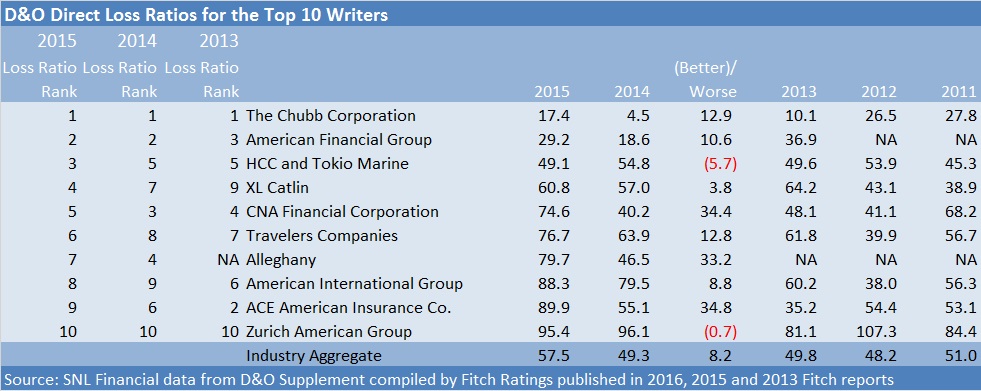The Chubb Corporation continued to report the best direct loss ratio for U.S. directors and officers liability insurance last year, according to a report released by Fitch Ratings last week.
But Chubb Limited—the combination of Chubb Corp. and ACE Limited—still lags behind American International Group in a ranking based on premiums, data presented in the report reveals.
Increasing concentration in the D&O market resulting from M&A activity and an unfavorable spike in the industrywide D&O loss ratio were two trends that the rating agency highlighted in its report, “U.S. Directors and Officers Liability Insurance 2016.”
The Top 10 writers of U.S. D&O insurance in 2015 accounted for nearly three-quarters of the market and the top five for just over half, direct premium figures in the report reveal.
Tokio Marine Group moved into the top five with its acquisition of HCC Insurance Holdings. The combination of Chubb and ACE did not figure into the premium rankings since ACE’s acquisition of Chubb did not close until Jan. 14 of this year. But even combining the premiums for the deal partners would put Chubb Limited’s market share at 14 percent—still ranking behind AIG’s 17 percent share.

While M&A activity promises to shake up the premium rankings going forward—with Chubb’s premium volume now eclipsing XL Catlin—a ranking based on loss ratio performance has remained fairly consistent over the years. Pulling together direct loss ratio results published in Fitch’s D&O report this year and some prior ones, reveals that loss ratios for Chubb and American Financial ‘s loss ratio remained the best (lowest of the leaders) while American International Group and Zurich American continue to have some of the highest direct loss ratios among the top 10.
While almost every one of the top 10 D&O writers saw their loss ratios worsen last year, ACE and CNA reported the greatest deterioration on a direct basis.
For the industry overall, while U.S. D&O premiums flattened in 2015—remaining at the $6.4 billion level recorded in 2014—the industry aggregate direct D&O loss ratio soared 8 points to 57.5, Fitch reported, suggesting that a new—and unfavorable—loss ratio trend may be emerging.
The 8 point jump came after four consecutive years of loss ratios hovering around the 50 point mark. The flattening of premium in 2015 meanwhile followed premium growth of 7 percent, on average, for the three prior years—2012-2014.
“D&O insurance pricing fared better than many other commercial market segments in recent years,” said Fitch Managing Director James Auden. “However, past profitability and strong underwriting capacity are promoting pricing competition that fosters less favorable underwriting results going forward,” he said in a statement about the report.
Results in 2016 will determine whether this change in results is representative of a new trend in performance or an aberration, the rating agency said, in its report, pointing to changing prior-year loss reserve development patterns as another possible indicator of a new trend that will unfavorably affect earnings going forward.
There was at least one aberration in net of reinsurance loss reserve development experience that Fitch also analyzed in the report—this time for the other liability-claims made line (OLCM, which includes D&O and professional liability). The aberration was adverse development reported by market leader AIG, which flattened overall industrywide development in 2015 overall after nine straight years of favorable prior-year development.
Reading teas leaves in more common reserve patterns, the Fitch report suggests fewer reports of reserve takedowns in the years ahead for other D&O insurers. “Past favorable development in OLCM originated substantially from mature underwriting periods prior to 2008. Most recent accident years are less likely to generate strong favorable reserve redundancies,” the report said.
The Fitch analysis highlights some other developing sources of uncertainty for D&O insurers—and their insureds as well, including federal government activity in holding individual directors and officers accountable for corporate misconduct and D&O risks from cyber threats.
Referring to the federal government, the report notes that the Department of Justice released what is known as the “Yates Memorandum” in September 2015, indicating that future corporate criminal and civil investigations will focus on both corporations and individual employees culpable of wrongdoing—and that the resolution of cases may be more likely to involve charges against individuals.
Among the potential outcomes–corporations will have greater incentive to cooperate by identifying responsible individuals, and coverage purchasing patterns may change—with individual officers seeking their own private liability protection outside of traditional D&O insurance.
As for cyber, D&O exposures arise through allegations that ineffective or negligent corporate governance and board oversight were contributing factors behind inadequate systems defenses and a breach that led to losses or share value declines, the report notes. How big settlements will be for recent severe cyber events has yet to be determined, but Fitch suggests that more cyber incidents could create more potential for cyber-related D&O actions going forward.






















 What to Expect in 2026: U.S. P/C Results More Like 2024
What to Expect in 2026: U.S. P/C Results More Like 2024  Artificial Intelligence Is Rewriting the Rules for Commercial Lines
Artificial Intelligence Is Rewriting the Rules for Commercial Lines  Berkshire Hathaway Enters Post-Buffett Era as Share Prices Fall
Berkshire Hathaway Enters Post-Buffett Era as Share Prices Fall  Why ‘Good Enough’ Is Killing Insurance: The Hidden Cost of Satisficing
Why ‘Good Enough’ Is Killing Insurance: The Hidden Cost of Satisficing 









